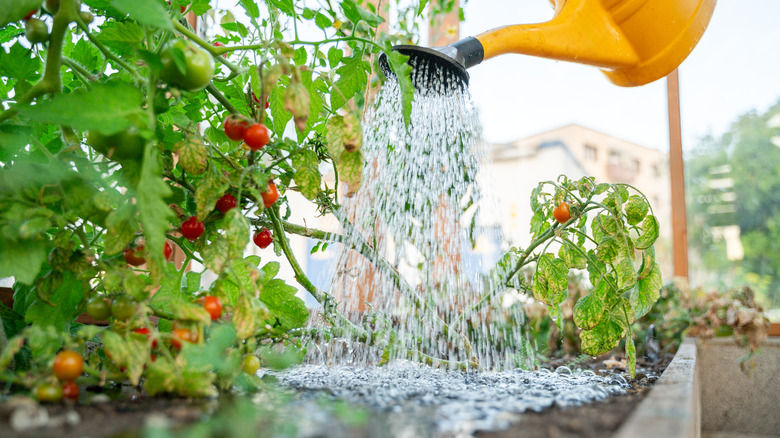Keep Your Tomatoes From Cracking And Splitting With A Simple Watering Tip
Is there anything more frustrating than patiently waiting for tomatoes to ripen, only to find them cracked or split right before they're ready to harvest and enjoy? If you keep finding your beautiful tomatoes with a slit or crack in their skin, you might be wondering what the issue is and whether there's anything you can do about it. The good news is that, yes, you can prevent cracking and splitting tomatoes with easy methods. One way to keep tomatoes looking perfect is through a thoughtful and consistent approach to watering.
Tomatoes tend to split and crack because of changes in their watering levels. If you're planting tomatoes out in the open, they're more likely to crack if a heavy rain is followed by a drought, or vice versa. In greenhouses, where tomatoes tend to thrive, you can better control the moisture level of the soil. If you don't already have one, you can DIY a greenhouse out of a shade tent or other items you already have at home. Either way, being on a consistent watering schedule and routine is your best line of defense against split tomatoes.
And the issue with split tomatoes isn't just aesthetics. Once a tomato cracks, some nasty bugs can start to feast on the interior flesh. Soon enough, there could be mold and fungus growing and spreading inside the split tomato, even as it starts to repair itself. If you're dealing with a cracked tomato that's not quite ripe yet, consider picking it and letting it ripen off the vine. If the tomato is ready to be eaten, simply cut the split part off, and you will be able to eat the rest safely.
How to water tomato plants to avoid splitting
Following a strict and consistent watering routine is one of the handiest hacks to remember when growing tomatoes. You want to avoid tomatoes having inconsistent access to water, which is what may cause them to split and crack. The simplest way to do this is to follow a regular schedule and make sure that there are no extreme fluctuations in watering from one week to the next.
The ideal amount is one inch of water each week or slightly more, though you can adapt based on the weather using a simple trick: the finger test. If you're not sure whether to water yet, stick your finger about an inch into the soil where the tomato plant grows. If the soil is still damp, you should be safe to wait and repeat the test the following day. If the soil feels dry to the touch, it means you should go ahead and water. This is a great way to make sure that tomato plants have access to consistent moisture and prevent the fruits from splitting and cracking. This is particularly helpful during hot summer months, when the soil might dry faster than you realize.
And when watering tomato plants, focus only on the soil. The water should penetrate the ground's deeper layers, too, and there is no need to wet the leaves, vines, and fruit (actually, it's best to avoid it). Therefore, stay away from sprinklers and use a hose or narrow-neck watering can where you can direct all of the water straight towards the roots.

